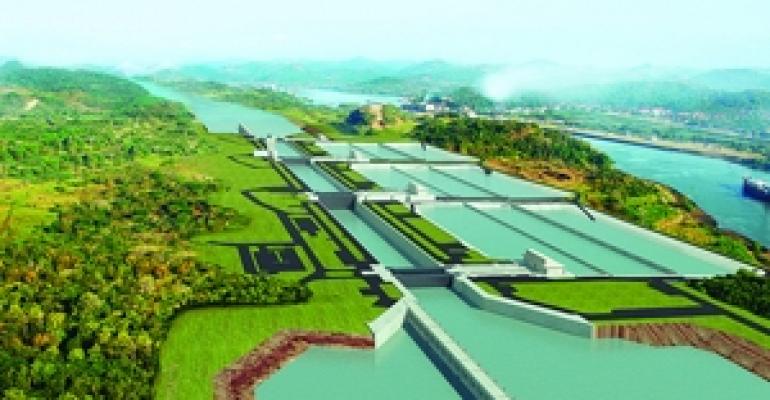Amazon has spoiled the country with fast shipping, and the expectation of instant purchase gratification—brought by efficient distribution methods, better rail logistics and massive cargo ships that will dock daily at deep, modern ports—grows more pervasive every day.
As U.S. ports prepare to handle more and more massive ships, including through the Panama Canal expansion, the attention and spending on infrastructure may one day allow the holy grail of shipping to be reached: A person orders an item off the Internet in the morning, and it’s shipped to their house by the evening.
Logistic experts believe the nation will see one-day shipping as the norm, as well as increased efficiency through the country’s distribution system, in the near future thanks to what is being called Panamax—the term for the new size limits for ships traveling through the Panama Canal. The one-day shipping wave is expected to get a large boost when the $5.2 billion Panama Canal expansion is complete in two years.
The pressing U.S. concern, at least on the East Coast, was in getting the ports ready to handle these large ships, which can carry up to 12,000 20-ft. equivalent units (TEUs). While the West Coast ports, which handle about half of the nation’s shipping, are already deep enough and equipped with newer equipment, the major East Coast ports still have infrastructure problems, illustrated by New York’s $1 billion effort to raise the Bayonne Bridge and Miami’s attempts to rectify its dredging and freeway connection concerns.

The good news, according to John Carver, global director of Jones Lang LaSalle’s ports, airports and global infrastructure group, is that the canal construction effort, which has been delayed by rainy weather, is not expected to be completed until at least the second quarter of 2015. “That’s given everyone a little breathing room to prepare for receiving the larger vessels, as well as more time for the development of commercial real estate infrastructure,” he said.
A few ports need the extra time to make ready, including Port Authority of New York and New Jersey, has yet to start work on raising the bridge. Once finished in 2015, the port should join Baltimore and Norfolk, which are at the required 50-ft. depth, and Miami is expected to complete its dredging by next year.
Carver, who moved his office from the West Coast to the Miami area, said it’s a fallacy that the West Coast will suffer losses due to the Canal opening up big-ship movement to the East Coast and Southeast ports. “The West will still dominate the speed-to-market cargo, such as televisions and ladies’ fashions,” he says. “We feel all the ports will raise their game, and the East Coast ports will grow because of efficiencies of scale with the expanded canal.”
However, K.C. Conway, Colliers’ executive managing director of real estate analytics, says every large U.S. port is trying to get some skin in the post-Panamax game, and that the West Coast is being somewhat facetious if it isn’t acknowledging a challenge to its dominance.
“The West Coast guys want you to believe the canal expansion isn’t a big deal to their bottom line, but it is,” Conway says. “You just look at the institutional capital invested in the California ports, they have a lot financially at stake.”
The challenges for the U.S. ports, followed by the country’s industrial property sector, will be in the chase by each port for the same traffic and the same dollars. While California is still the dominant market, other states are stepping up, Conway says. That includes Houston’s dominance with oil shipping, Charleston’s determination to get 50-ft. deep by 2017 and even Savannah’s concentration on agricultural products.
And don’t forget possible strikes: The International Longshoremen’s Association agreed to extend its contract negotiations until after the massive holiday rush. The new deadline, which could incur strikes if no deal is reached, has been pushed to early February.
Other challenges, Conway says, include the competition amongst the port cities and just the strength of the state financial situations. Illinois, for example, has the busiest intermodal activity through the Chicago corridor (to the point of now being a choking bottleneck), but the weakest financial stability of the top 21 industrial port communities.
However, there are bright spots, Conway notes. As China’s massive demand somewhat dims, Latin America is expanding. Also, U.S. logistics companies and retailers are now able to view a new Ocean Shipping Container Availability Report, continuous research created by the federal government in July 2012 to track the surpluses and shortages of TEU containers in 18 of the inland intermodal ports.
These intermodal facilities are just going to keep growing near major population centers, Conway says, as rail becomes again the top investment for the nation’s efficient logistical product movement.
“We’re going to move more of the cargo handling off of trucks and onto rail, and the logistics and distribution sectors, including massive retailers such as Amazon, Home Depot and Walmart are now looking at the best way to ship in volume,” he says. “All rail indicators are up, including intermodal use and employment.”

